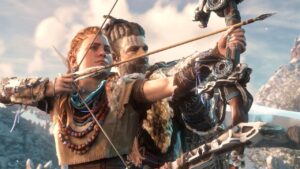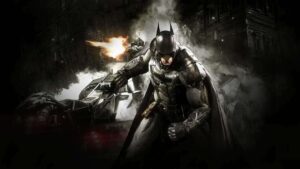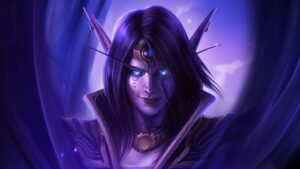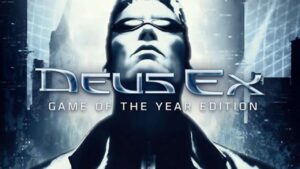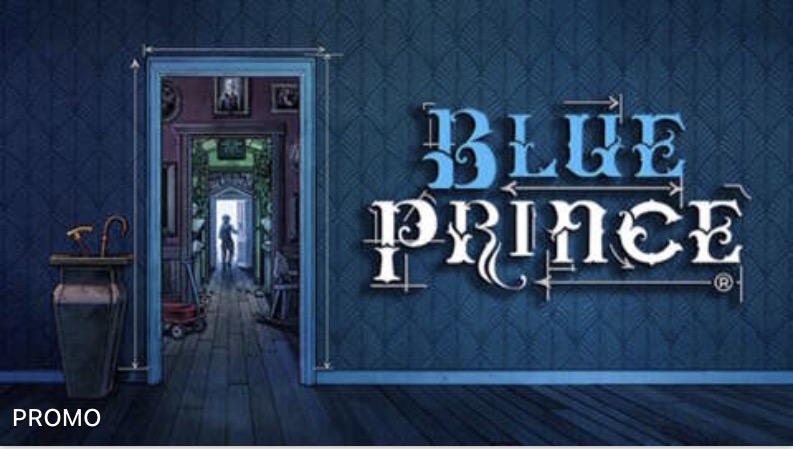After its predecessor served as a beacon of novelty amidst a sea of stagnation, Death Stranding 2: On The Beach had a big challenge to overcome. Death Stranding’s absurd nature, encompassing everything from urine grenades to gently rocking your controller to calm a distressed baby, was coupled with a rich new setting to unravel. Step by step, Sam Porter Bridges connected a post-apocalyptic America to a network by making dozens of deliveries from one point to another. Its slow and methodical pace made it somewhat of an outlier in the AAA space. The sequel follows suit in most ways that made its predecessor stand out. The core foundation remains unchanged–planning and executing each delivery requires strategy and improvisation, and they’re still satisfying to pull off. But this second iteration doesn’t feel as arresting as it mired in familiar story beats, a disappointing lack of friction, and an obsession with doubling down on the weaker aspects of Death Stranding.
Gallery
The story begins with Sam living a reclusive life near the Mexico border with Lou, the now-grown baby from the first game. A familiar face inevitably finds Sam and, once again, asks for help connecting an array of facilities to the network. This time, your destinations are fictional depictions of Mexico and Australia, and the journey involves collaborating with a growing crew of characters that cruise around with you in the DHV Magellan, a Metal Gear-shaped ship serving as the base of operations.
Throughout the 33 hours it took me to reach the end credits, which included a few side activities along the way, the story focused on the effects of connecting the United States to the Chiral Network, while uncovering the whereabouts of returning characters. Sam’s new tale is told sporadically, which feels like watching a very slow season of a TV show. Completing main missions grants enough parcels of story here and there to keep you engaged, but I spent a lot of time longing for a cutscene or conversation that might shed a little clarity or answers to mysteries introduced early on, as cutscenes sometimes fail to deliver relevant information or any character development. That being said, while some of the eventual revelations weren’t as impactful as I had hoped, my interest in seeing the story through didn’t wane.
It doesn’t help that the new cast of characters, with the exception of a handful of touching scenes and well-choreographed fights, isn’t as compelling as the old crew. Fragile, one of the returning companions, becomes a Charles Xavier-like figure, slowly recruiting new members of the crew to join the ship and offering support in harnessing their signature powers. Characters like Rainy and Tomorrow have their spotlights during cutscenes, and you learn more about their backstories in the form of flashbacks, albeit in short bursts. Rainy can, well, manifest rain, while Tomorrow’s abilities include being able to move inside Tar, a black liquid from which Beached Things (BTs), Death Stranding’s trademark enemies, manifest. Their arcs, however, merely consist of introducing the character and their motivations to “join the cause” and help Sam, as opposed to the likes of Heartman or Deadman, who already seemed established in the world by the time you met them in the previous game.
There’s also a surprising lack of dialogue outside of cutscenes, with the crew being less prone to calling Sam like in the first game. They instead use a social media-type app to post updates, usually pointing to places of interest or providing follow-up context to certain milestones achieved during the main story. During your travels, Dollman, a literal doll and recurring companion who delivers occasional commentary from Sam’s waist does most of the talking. The remaining cast feels almost sidelined as a result, especially if you aren’t fixated on main missions, where they usually are confined to. Dollman can be thrown to the air to survey the target area and both tag enemies and distract them, so he’s usually a mainstay. The rest of the crew, aside from a very late game mechanic, don’t provide much support.
The moment-to-moment structure remains largely the same. You interact with a terminal inside a facility or a bunker to grab a delivery order, make a plan by preparing your inventory and crafting any necessary equipment you might need, and off you go. After the first handful of hours, however, a different focus becomes increasingly apparent, doubling down on a post-launch revision on the original experience. 2021’s Death Stranding: Director’s Cut indicated an intention to downplay Sam’s vulnerability in the original version, in which he was a simple porter who had to make do with tools and non-lethal weapons to fend off BTs while making sure that the cargo on his shoulders remained intact. Even outside of combat, cruising through different terrain demanded careful consideration of weight and stamina. The Director’s Cut, however, empowered Sam by increasing the available tools to defend himself and navigate the world more easily. It favored more action, introducing more weapons, a firing range, and vehicle races. It also included gadgets that could simplify some of the terrain hardships, thereby reducing the challenge of traversal. A cargo catapult, for example, could be used to shoot packages large distances, and delivery bots introduced some automation.
At first, it seemed as if Death Stranding 2 was aware of these additions and the repercussions, providing commentary about their role in its fictional world. The delivery bots, for example, are now used en masse, largely eliminating the need for actual human porters like Sam, who build connections in a world of isolation. The presence of weapons, however, has much bigger implications. In an early confrontation, Sam’s first reaction is to grab a knife. He then grabs a bigger blade and immediately gives it up in favor of a pistol inside a kitchen drawer. For a moment, he glances at Lou, looks at the gun, and ditches it for a pan instead.
The scene with Lou showcases that, even in a world surrounded by strange beings that manifest themselves from the land of the dead, Sam deems it important to avoid being a bad influence on Lou. Yet, the sequel is constantly pushing for the use of weapons. From a story perspective, it’s an intriguing parallel with the presence of the new villain, who commands a group of military skeletons carrying fire weapons. During his introduction, characters promptly mention that the United States used to have a prominent gun culture, which is now being perpetuated by the evil actors in the story.
Most orders you complete reward you with new firepower. In the first Death Stranding, I spent most of my playthrough avoiding weapons, as using different grenades and other tools was a more interesting solution than just shooting at weak points. With the sequel, I wasn’t as inclined to do so. It became apparent that it was more efficient to carry grenade launchers before a boss fight. Toward the latter half of the story, multiple missions present Sam with large groups of enemies to contend with, in which stealth isn’t an option. There are still plenty of opportunities to approach combat with a far more methodical pace, or to avoid combat altogether by quietly hacking terminals or retrieving cargo from enemy outposts and quickly bursting out of the area. Stealth is still a viable option with plenty of tools to use, such as the rope for quiet takedowns from behind, the Bola gun to tie up enemies at range, and grenades to incapacitate foes or conceal yourself. Navigating the environment, too, has an impact–it’s easier to remain undetected if you infiltrate a hideout during the night and avoid making noise. But the main story forced my hand more often than not and, as a character tells Sam, “change my rope for a stick.”
The sequel retains [the tension of] executing a plan while overcoming hurdles as smartly as possible, but there’s a clear intention to provide high-end tech early on, which in turn undermines some of [its] unique core mechanics
Death Stranding’s design stood out because a miscalculated step during a hike resulted in a fall that damaged your cargo, which was always disheartening to see unfold in real time. It hurt to see packages tumbling down a mountain or being carried away by the rapid waters of a river, forcing fast decision-making to try and salvage the delivery. Moments like this created tension through the looming threat that a 20-minute delivery could crumble at any point before reaching your destination. This aspect of the original game felt more impactful than, say, failing a boss fight, which you could simply retry by reloading a checkpoint.
The sequel retains this tension in executing a plan while overcoming hurdles as smartly as possible. But there’s a clear intention to provide high-end tech early on, which in turn undermines some of those unique core mechanics. In the first game, access to vehicles– especially trucks that can carry tons of cargo and push through most terrain with ease, or exoskeletons to improve Sam’s stability and overall agility–were tantalizing goals you had to patiently work towards. After the first few dozen main orders of the sequel, I already had access to them, diminishing the need for carefully placing tools like ladders. It’s still possible to progressively build shortcuts for myself and others. You can also just create a truck and upgrade it over time, adding battery packs to increase its use, a turret that automatically targets enemies, and a tool that picks up nearby cargo without stopping. The altruism that was at the core of Death Stranding feels less vital. Although this makes the game more immediately playable, the loss of friction also diminishes something really cool the series was doing. Of course, you can choose to ignore these “shortcuts” if you want something closer to the original.
Dynamic weather conditions are added into the mix alongside Timefall, a rain that quickly ages and erodes everything it touches–another naturally occurring obstacle that poses new challenges and considerations. Sandstorms impact visibility and push Sam toward the direction of the wind, which is a dangerous predicament without an exoskeleton or a place to hunker down until they pass. Crucially, moving during periods of strong winds decreases Sam’s stamina considerably. Avalanches can ruin a hike attempt across snowy regions with ease if you happen to be in the way, while earthquakes can disrupt your balance if you don’t firmly hold onto your cargo on time for their impact. Depending on your playstyle, weather conditions can significantly slow you down.
Over time, you can also gain the ability to get a weather forecast. This is a great pairing for the returning map feature, which allows you to manually plot delivery routes by dropping pins and tracing a path. During your actual trek, you’ll see them as markers in the distance, with a wave of lights that stretch into the sky tracing the path, allowing you to stay on track. Still, it serves more as a visual reference than an actual, carefully planned route, as the map isn’t entirely clear about ravines, the depth of certain bodies of water, and so on, until you’re actually on the spot. But it can come in useful to discern which paths present visible threats, like enemy outposts.
Death Stranding 2 struggles to add new novelty to an already-distinct foundation set by its predecessor. Additions, such as dialogue choices, player stats, and skill trees, are introduced as promising mechanics at first. For dialogue options, there are ways in which the game subverts your picks during conversations, which are fun to see, but don’t expect them to have ramifications in the story. The stats and skills are tied together–depending on your actions during deliveries, you gain points toward upgrades related to, say, stealth or map navigation. This introduces a layer of character progression, but the changes aren’t significant. These are interesting additions or small enhancements to Sam’s mobility and the capabilities of certain tools that are nice-to-haves more than being a significant shakeup for the sequel, especially if you lean on the high-tech tools you can get early on, sidelining most of these upgrades. At the very least, they add just a smattering of variation to the gameplay template. It’s still satisfying to roam around and see how the environment begins to be populated by signs, holograms, and structures built by other players, as well as logging into the game and getting notifications about everybody who liked the creations you left behind while you were offline. But unless you skipped the first game, there isn’t much about the sequel that feels new.
In fact, Death Stranding 2 basks in familiarity. The villains are both a returning character who, after the initial introduction, theatrically spews basically the same speech in every encounter with Sam since that point. The new antagonist, meanwhile, follows an established archetype, albeit with quieter narrative impact. Some key scenes and confrontations play out almost the same as they did in the first game, too. There are some meta moments involving characters communicating by breaking the fourth wall and purposefully gamified conversations, all reminiscent of the past work from Kojima Productions, but they’re few and far between. Even more clear are the many homages to the Metal Gear Solid series, at times evoking iconic scenes. There are too many winks and nods, sometimes as direct as an actual quote, that place key scenes in distracting fan service territory, rather than allowing the world of Death Stranding to flourish on its own.
This obsession with honoring past legacy also carries the baggage of some of the series’ worst tropes, particularly around the portrayal of women, which the first game was also guilty of. While I can’t speak with authority about some of the sequel’s plotlines, including one involving a phenomenon around childbirth, some scenes caused an exhausting déjà vu; there’s an unskippable photography minigame featuring three women posing in front of the camera, as well as a central character who often takes her shoes off as crew members make a running commentary about this habit. The camera pans during cutscenes aren’t as excessive as, say, the treatment around Quiet in Metal Gear Solid V: The Phantom Pain, but it all feels unnecessary. And since you’re witnessing photo-realistic depictions of real-life actors, it can slip into being a bit weird.
Hitting the end credits came with the painful realization that Death Stranding 2 can’t rekindle the novelty of its world and characters as effectively the second time around. Ironically, it feels like a more ordinary experience, which makes sense as a sequel that isn’t looking to be as disruptive with new ideas as it was the last time. While some may enjoy the more action-oriented approach, I found the focus on weapons and easier access to tools clashed with the meditative experience of doing deliveries on foot and trying to avoid danger that was present in its predecessor, especially with more missions that purposefully pit you against enemies with all sorts of high-end weapons.

Gallery
Hideo Kojima, head of the studio, has said in interviews that he wants the sequel to be divisive to avoid falling into the entertainment category of being “easy to chew, easy to digest.” Despite that intention, Death Stranding 2 tries to be amicable to players who might have had difficulties with the learning curve of the first game, both in terms of lore exposition (adding a codex that is updated every time someone mentions a new noun) and gameplay standpoints (giving you more tools to make things easier early on). Toward the end of the story, I began to see Death Stranding 2 as a commentary on how even novel ideas can reach a little further if presented via a more hospitable experience. There’s an emphasis on repetition that permeates the story, both in the routine involved in preparing yourself for deliveries, and Sam being a Repatriate who can resurrect after dying. Seeing familiar narrative beats and character archetypes repeat themselves in the sequel feeds into this reading, but also puts constraints on its potential.
The first Death Stranding was eerily prescient. Releasing in 2019, it was impossible to divorce it from the COVID-19 pandemic that followed a year later, the parallels between preppers living in bunkers and people struggling to find ways to connect with others reflecting a period of quarantine and uncertainty about the future. By contrast, Death Stranding 2 is less precise and clear about what it wants to say; it seems committed to making you ponder many things at once, inviting different takeaways. Its story touches on topics like the increasing harms of climate change, how our everyday actions are being automated with each passing day, the damaging presence of guns, the clash between governments and privately owned entities, and the importance of helping others in any way we can. If the sequel is prescient of anything, it is that fixation on the past binds us to repeat history, no matter how much we try to pretend otherwise.




